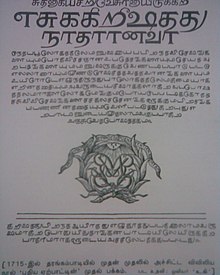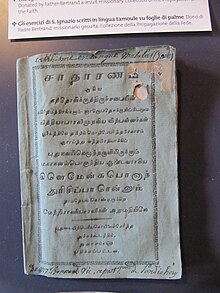Printing in Tamil language
This article includes a list of general references, but it lacks sufficient corresponding inline citations. (July 2020) |

The introduction and early development of
These developments took place at a time when other locations such as Madurai were still confined to the use of copper plates and stone inscriptions. This book was printed earlier than the first printed and dated books of Russia (1563), Africa (1624) and Greece (1821).[1]
Henriques and the sixteenth century

The appearance of Tamil in print, both in Roman transliteration and in its native script was the result of the convergence between
Around 1575 Henriques was relieved of his
In 1577 the first of the Henriques’ five books,
- A Confessionary (Confessionairo) 1580 (214 pages)
- Lives of Saints (Flos Sanctorum), 1586 (669 pages)
Roberto De Nobili and the seventeenth century
In the 17th century, Tamil books were printed at
Unlike Henriques, Roberto de Nobili did not translate a Portuguese text into Tamil, instead he wrote his own manual, so that he might emphasize the hidden truths of the new faith.
Ziegenbalg and printing in Tranquebar
Bartholomäus Ziegenbalg was the pioneer in the setup of a printing press at Madras. In South India the printing press had been established as early as 1578, but printing activities came to an end owing to a gradual decline in the religious zeal of successive generations of missionaries. Tamil printing stopped after 1612, as the numerous writings of Nobili and Manoel Martin lay unpublished in 1649 and 1660. There were some attempts to revive printing, but they proved short-lived. For instance, there is a reference to a Latin–Tamil grammar by Father Beschi, a Sanskrit scholar, having been printed at Ziegenbalg’s press.
Ziegenbalg explained in a number of letters that the books prepared in the Malabar language, to help in the propagation of the
In a letter written in 1708, Ziegenbalg speaks of 26
Ziegenbalg was keenly aware that to attain his object he needed a printing press. He made repeated demands for a press in his letters of April–June 1709. The Society for Promoting Christian Knowledge, set up in the 1690s, came forward to help under the recommendation of the Rev. A. W. Boehme (the German chaplain to Prince George of Denmark). In 1711 the society sent the mission some copies of the Bible in Portuguese as well as a printing press with pica types and other accessories along with a printer to operate it. The ship was held up by the French near Brazil, and the printer Jones Finck was arrested but later released. Finck soon succumbed to fever near the Cape of Good Hope. The printing press reached India in 1712 unaccompanied by its operator. The press, however, started functioning with the help of a German printer–cum–compositor.
Malabar characters were obtained from Europe. A letter dated April 7, 1713, contains a list of 32 books in the Malabar language, original works as well as translations, and 22 books in Portuguese prepared by the missionaries. It is stated that the books in the Malabar language included a vocabulary written on paper and another written on
According to a letter of January 3, 1714, the work of printing the New Testament in Tamil had already begun. Another letter of September 27, 1714, states that, "The Four Evangelists and Acts of the Apostles" was already printed. Reportedly, this is the oldest Tamil book printed at Tranquebar, a copy of which is available at the Serampore College Library. From 1715 onwards with the completion of the New Testament, printing activity in Tamil commenced in full swing. In 1715 Ziegenbalg wrote a concise grammar of the Malabar language for use by Europeans and had it printed by 1716. A copy of this book also exists at the Serampore College Library. Ziegenbalg and his collaborators aimed at spreading their printed work all over India. Consequently, their marketing strategies cajoled them to produce
Constanzo G. Beschi

Parallel to printing efforts by the Protestant missionaries at
Contrary to this image, Beschi has also been examined as a magical Indian "poet-saint" with extraordinary literary skills and persuasion prowess. Beschi's written works constituted the substructure of modern Tamil literary acculturation. According to sources, Beschi wrote more than twenty books :– dictionaries,
Guru Simpleton
Beschi's Guru Simpleton (which occupies a status similar to The Arabian Nights or The Panchatantra in Tamil culture) is a blend of the oral tradition of Tamil folklore and the European story form, wrapped in the author's imaginative faculty. Although Beschi had completed its composition (along with a preface) by 1776, the book was not published singularly until 1822 in London. Records show that Beschi wrote the Tamil version first and later translated it into Latin. Although Beschi claimed that the sole purpose of the book was to disseminate amusement and humour among both locals and missionaries, Blackburn mentions that the author was most probably yearning for something more than that – “this was a plea for a Jesuit patron, somewhere outside India, to underwrite the publication of his dictionary and folktale”,
Printed oral tales in Tamil
In the history of print in early nineteenth-century India there were an enormous number of books of oral literature, especially folktales published. Between 1800 and 1835 most printed books in Tamil(dictionaries and grammars aside) were collections of oral tales. Well known literary texts, such as Tirrukkural and Nalatiyar, also appeared in print, but these classical texts were outnumbered by books of oral tales.[8] The first of these was Vikkiramatittan Katai, a collection of folktales in the framework of a literary tale which appeared in 1804, followed by the Catamuka Ravanan Katai in 1808; the Mariyatai Raman Katai and Tamilariyum Mantai Katai in 1812; the Pururava Cakravarti Katai in 1819; the Katamantacari, a collection of oral tales in 1820; the Tamil – English bilingual publication of Paramartta Kuruvin Katai (Guru Simpleton) in 1822 (in London); a Tamil Pancatantra in 1826; the Katacintamani, another collection of oral tales, in 1833; and translations of tales from English, French and Aesop by the 1850s. Some of these books are still available today.
Printing by Pundits
A number of early Tamil print publishing houses were set up by the pundits in the 1830s in Madras. These establishments played a significant role in the consolidation of the commercial printing world. They were also involved in public–politics, the anti–missionary movement in Georgetown, for instance. Pundits who were educated at the College Fort of St George and some who were not, used the text-making skills they learned from the Europeans in setting up of their own presses at Madras.
The rise of the pundit - presses saw growth during the 1830s with Kalvi Vilakkam, the joint venture of Charavanaperumal Aiyar and Vichakaperumal Aiyar in 1834. The press functioned till the 1850s producing more than 50 books. This was followed by the Sarasvati Press (1835) of Tiruvenkatachala Mutaliar, and Kalvi Kalanchiyam set up in 1839 by Umapati Mutaliar and his three brothers.[9] These presses quickly became associated with movements in deflecting the missionaries as they started voicing the sentiments of certain sections of the Hindu community.
In the context of printing, Arumuka Navalar or Arumuga Navalar was an editor of old Tamil texts. Among his editions the most important are Mantalapurutar's lexicon cutamani nikantu with commentary (first printed in 1849), the standard medieval grammar
Arumuga Navalar apparently introduced few novel features in the area of Tamil editing. He was probably the first to use punctuation marks like the semicolon, the question mark and the exclamation mark. He produced the first “split” complex sandhi forms to facilitate reading and comprehension.
Madras School Book Society
The
The publications of the Madras School Book Society being chiefly used in Government Schools such that religious sentiments were adapted accordingly. The committee of the Madras Tract Society issued some books with Christian elements intended specially for mission schools[11] Classified catalogue of Tamil printed books, with introductory notices. Though reading books of the Madras School Book society were prepared with special reference to the government schools, the committee was not restricted to non–Christian publications. The Rev. A.R. Symonds suggested that the society should make an effort to provide wholesome and attractive literature. Prizes were also offered for the best translation of Robinson Crusoe.
Printing in Sri Lanka
Vepery Press

Madras was the foremost seat of printing among the “colonial metropolises”. The
By 1766, Vepery got its own press supplemented with its own print equipment. Therefore, the presses confiscated from
Notes
- ^ Karka...Nirka... Blog on Tamil Literature
- ^ A.K. Priolkar
- ^ Stuart Blackburn (2006), Page 45
- ^ Stuart Blackburn (2006), Page 48
- ^ A. Raman
- ^ Stuart Blackburn (2006), Page 49
- ^ Stuart Blackburn (2006), Page 66
- ^ Stuart Blackburn (2004), Page 122
- ^ Rimi B. Chaterjee
- ^ Stuart Blackburn(2006). Page 125
- ^ John Murdoch, 1865
- ^ S.H.M. Jameel (1994). 'Suwadi Aatruppadai'
- ^ J.B. Prashant More, Page 80
- ^ Stuart Blackburn(2006) Page 58
- ^ A. Raman
References
- Stuart Blackburn (2004). "The Burden of Authenticity",India's Literary History: Essays on the Nineteenth Century
- Stuart Blackburn (2006). "Beschi and the Lutherans", Print Folklore and Nationalism in Colonial South India]
- A.K. Priolkar. The Printing Press in India
- J.B. Prashant More (2004). Muslim Identity, Print Culture and the Dravidian Factor in Tamil Nadu
- Rimi B. Chatterjee. "Outlines of a Discipline : Book History in India" Paradise: new worlds of books and readers (2007)
- J. Murdoch. Classified Catalogue of Tamil Printed books, with introductory notes (1865)


